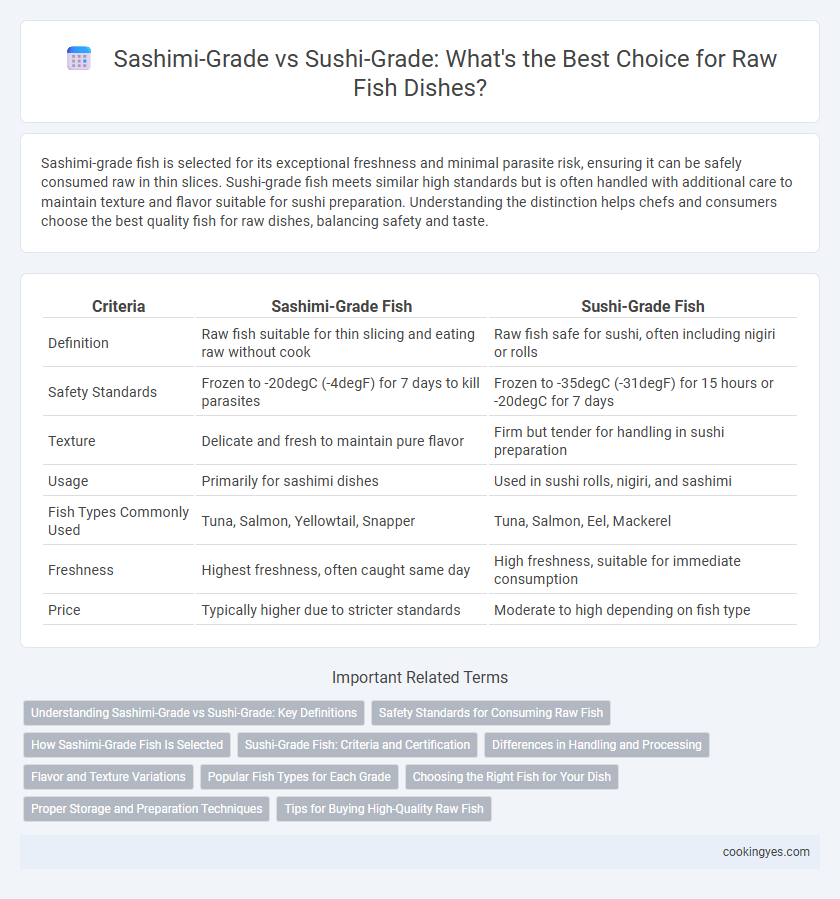Sashimi-grade fish is selected for its exceptional freshness and minimal parasite risk, ensuring it can be safely consumed raw in thin slices. Sushi-grade fish meets similar high standards but is often handled with additional care to maintain texture and flavor suitable for sushi preparation. Understanding the distinction helps chefs and consumers choose the best quality fish for raw dishes, balancing safety and taste.
Table of Comparison
| Criteria | Sashimi-Grade Fish | Sushi-Grade Fish |
|---|---|---|
| Definition | Raw fish suitable for thin slicing and eating raw without cook | Raw fish safe for sushi, often including nigiri or rolls |
| Safety Standards | Frozen to -20degC (-4degF) for 7 days to kill parasites | Frozen to -35degC (-31degF) for 15 hours or -20degC for 7 days |
| Texture | Delicate and fresh to maintain pure flavor | Firm but tender for handling in sushi preparation |
| Usage | Primarily for sashimi dishes | Used in sushi rolls, nigiri, and sashimi |
| Fish Types Commonly Used | Tuna, Salmon, Yellowtail, Snapper | Tuna, Salmon, Eel, Mackerel |
| Freshness | Highest freshness, often caught same day | High freshness, suitable for immediate consumption |
| Price | Typically higher due to stricter standards | Moderate to high depending on fish type |
Understanding Sashimi-Grade vs Sushi-Grade: Key Definitions
Sashimi-grade fish is specifically selected and handled to meet stringent freshness and safety standards for consumption raw, ensuring the highest quality for delicate slicing and presentation. Sushi-grade fish also adheres to strict criteria but may have slight variations in handling or freezing methods tailored to sushi preparation, emphasizing texture and flavor compatibility with vinegared rice. Understanding these key definitions helps consumers and chefs choose the appropriate fish type for raw dishes, prioritizing safety, texture, and taste.
Safety Standards for Consuming Raw Fish
Sashimi-grade and sushi-grade fish both meet strict safety standards to minimize the risk of parasites and bacterial contamination, with FDA regulations requiring freezing at specific temperatures to kill parasites. Sushi-grade fish undergoes rigorous inspections and handling protocols to ensure freshness and pathogen control, making it safe for raw consumption. Proper sourcing from reputable suppliers and adherence to cold chain storage are critical for maintaining the safety and quality of raw fish dishes.
How Sashimi-Grade Fish Is Selected
Sashimi-grade fish is selected through stringent freshness and safety standards, including immediate gutting and chilling after catch to prevent bacterial growth. The fish undergoes skilled inspection for texture, color, and fat distribution, ensuring optimal taste and a safe, smooth raw experience. Only species with low parasite risk and traceability from trusted suppliers qualify as sashimi-grade for raw fish dishes.
Sushi-Grade Fish: Criteria and Certification
Sushi-grade fish is rigorously tested to ensure it meets stringent safety and quality standards for raw consumption, often certified by regulatory bodies through freezing protocols that eliminate parasites. This grade requires fish to be handled with exceptional care, maintaining cold chain integrity from catch to plate to prevent bacterial contamination. Certification commonly involves compliance with FDA guidelines or equivalent authorities, guaranteeing that the fish is safe, fresh, and of the highest texture and flavor quality suitable for sushi and sashimi dishes.
Differences in Handling and Processing
Sashimi-grade fish undergoes stricter freezing protocols to eliminate parasites, often frozen at -20degC for at least 7 days or flash-frozen at -35degC instantly, ensuring safety for raw consumption. Sushi-grade fish emphasizes freshness and is typically handled with rapid chilling and minimal processing to preserve texture and flavor, yet may not meet the same parasite destruction standards as sashimi-grade. Both require meticulous handling, but sashimi-grade prioritizes safety through rigorous freezing, while sushi-grade balances freshness with careful handling for optimal taste.
Flavor and Texture Variations
Sashimi-grade fish is selected for its delicate flavor and tender texture, ensuring a smooth, buttery mouthfeel ideal for thinly sliced raw dishes. Sushi-grade fish undergoes rigorous freshness and quality inspections, resulting in a slightly firmer texture and more pronounced umami flavor that complements vinegared rice. Flavor and texture variations between sashimi-grade and sushi-grade fish influence the overall sensory experience, making sashimi prized for pure fish taste while sushi-grade balances flavor intensity and texture with rice integration.
Popular Fish Types for Each Grade
Sashimi-grade fish includes popular types like tuna, salmon, yellowtail, and mackerel, known for their freshness and minimal parasite risk, making them ideal for thin, raw slices. Sushi-grade fish often features similar species but emphasizes strict handling and freezing processes to eliminate parasites, with common examples including bluefin tuna, snapper, and sea bream. Both grades prioritize fish sourced from cold, clean waters to ensure safety and optimal texture for raw consumption.
Choosing the Right Fish for Your Dish
Selecting the right fish for sashimi-grade or sushi-grade dishes hinges on freshness, texture, and safety standards. Sashimi-grade fish is meticulously handled to maintain pristine quality for raw consumption, ensuring minimal risk from parasites or bacteria. Sushi-grade fish often undergoes specific freezing protocols to meet regulatory guidelines, making it ideal for sushi and sashimi that require the highest quality and safety.
Proper Storage and Preparation Techniques
Sashimi-grade and sushi-grade fish require meticulous storage at temperatures below -20degC to eliminate parasites and maintain freshness, ensuring safety for raw consumption. Proper preparation involves using ultrafine, sharp knives to slice fish against the grain, preserving texture and flavor in dishes like sashimi and sushi. Maintaining strict hygiene and prompt refrigeration after purchase are critical to preventing bacterial growth and preserving the fish's optimal quality.
Tips for Buying High-Quality Raw Fish
Look for sashimi-grade or sushi-grade labels when buying raw fish, as these indicate the fish has been frozen to specific temperatures to eliminate parasites, ensuring safety for raw consumption. Choose fish with firm texture, bright color, and a fresh sea aroma, avoiding any off-putting or ammonia-like smells. Always purchase from reputable suppliers who prioritize freshness and proper handling to guarantee the highest quality for raw fish dishes.
Sashimi-grade vs Sushi-grade for raw fish dishes Infographic

 cookingyes.com
cookingyes.com